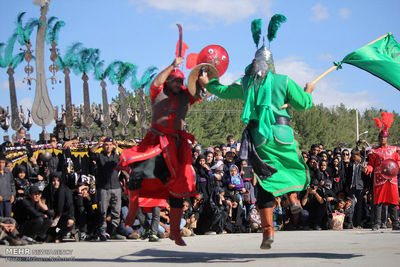“Tazieh is a ritual performance, which dates back to centuries ago in Iran and is performed during Muharram. It is not only a kind of performance but also a ritual play people have beliefs in,” Galledarzadeh said.
He asked for a solution to perform tazieh during Muharram, which is coming in two weeks in the midst of the coronavirus pandemic.
“Tazieh was long liked by many from the old days and many gathered to watch the performances, and that is why Dowlat Tekyeh was constructed,” he said.
Dowlat Tekyeh was a place for seasonal Islamic ceremonies that were built during the reign of Qajar king Nasser ad-Din Shah near the Golestan Palace downtown Tehran.
Tazieh was also performed in big squares and courtyards, which used to attract many viewers.
He added, “Those individuals who gather to watch the performance usually consider tazieh a kind of worship and while they are in the crowd, they break into tears with the scenes they watch, and they usually go back into their inner selves and experience a kind of privacy while in the crowd.”
He said that he believes the performances in the lunar months of Muharram and Safar present no problem.
“I believe it not only has no problem but it seems to be necessary because it can create a place for ritual performances while health protocols and social distancing are observed,” he said.
In a meeting with Galledarzadeh, Qader Ashena, the director of Iran’s Dramatic Arts Center, has said that the decision by the Coronavirus Combat and Prevention Headquarters is very important, and if there would be no threat for the performers and the viewers, tazieh performances will have no problem.
He said that he would like to have a meeting with the Health Minister to discuss the issue.
“These types of performances can be a good help for the artists while they can also make people occupied by the open-air performances,” he concluded.
Source: Tehran Times

